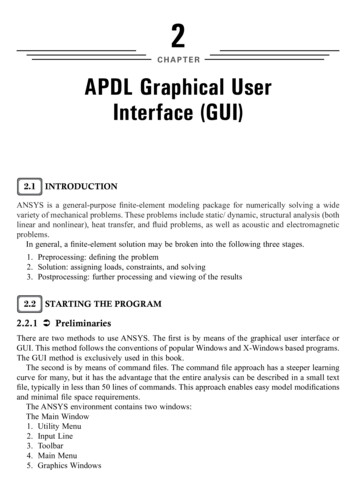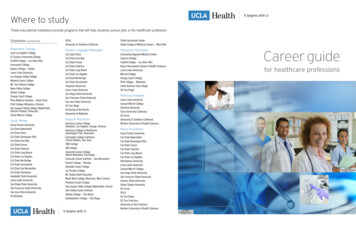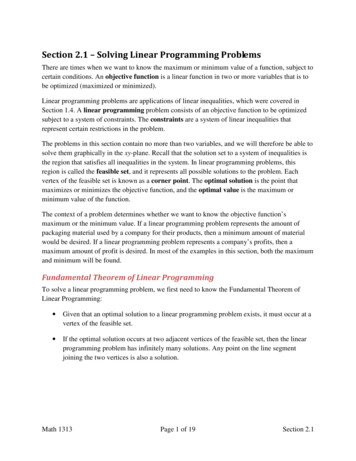
Transcription
SAMPLE PREFACE. NOT FOR DISTRIBUTION.A GRAPHICAL APPROACH TOCOLLEGEALGEBRASEVENTH EDITIONCopyright Pearson. All Rights Reserved.A01 LIAL9328 07 AIE FM i-xx.indd 113/10/17 2:24 PM
SAMPLE PREFACE. NOT FOR DISTRIBUTION.Copyright Pearson. All Rights Reserved.A01 LIAL9328 07 AIE FM i-xx.indd 213/10/17 2:24 PM
SAMPLE PREFACE. NOT FOR DISTRIBUTION.A GRAPHICAL APPROACH TOCOLLEGEALGEBRASEVENTH EDITIONJohn Hor nsbyUniversity of New OrleansMargaret L. LialAmerican River CollegeGary RockswoldMinnesota State University, Mankatowith the assistance ofJessica RockswoldCopyright Pearson. All Rights Reserved.A01 LIAL9328 07 AIE FM i-xx.indd 313/10/17 2:24 PM
SAMPLE PREFACE. NOT FOR DISTRIBUTION.Director, Portfolio Management: Anne KellyCourseware Portfolio Manager: Chelsea KharakozovaCourseware Portfolio Management Assistant: Ashley GordonContent Producer: Kathleen A. ManleyManaging Producer: Karen WernholmProducer: Marielle GuineyManager, Courseware QA: Mary DurnwaldManager, Content Development: Megan BurnsProduct Marketing Manager: Stacey SveumProduct Marketing Assistant: Shannon McCormackField Marketing Manager: Peggy LucasField Marketing Assistant: Adrianna ValenciaSenior Author Support/Technology Specialist: Joe VetereManager, Rights and Permissions: Gina CheselkaText and Cover Design: Cenveo Publisher ServicesProduction Coordination, Composition, and Illustrations: Cenveo Publisher ServicesCopyright 2019, 2015, 2011 by Pearson Education, Inc. All Rights Reserved. Printed in theUnited States of America. This publication is protected by copyright, and permission shouldbe obtained from the publisher prior to any prohibited reproduction, storage in a retrievalsystem, or transmission in any form or by any means, electronic, mechanical, photocopying,recording, or otherwise. For information regarding permissions, request forms, and the appropriate contacts within the Pearson Education Global Rights & Permissions department, pleasevisit www.pearsoned.com/permissions/.Attributions of third-party content appear on page C-1, which constitutes an extension of thiscopyright page.PEARSON, ALWAYS LEARNING, and MYLAB are exclusive trademarks owned by earson Education, Inc. or its affiliates in the U.S. and/or other countries.PUnless otherwise indicated herein, any third-party trademarks that may appear in this workare the property of their respective owners and any references to third-party trademarks, logosor other trade dress are for demonstrative or descriptive purposes only. Such references arenot intended to imply any sponsorship, endorsement, authorization, or promotion of Pearson’sproducts by the owners of such marks, or any relationship between the owner and PearsonEducation, Inc. or its affiliates, authors, licensees or distributors.Library of Congress Cataloging-in-Publication DataNames: Hornsby, John, 1949- author. Lial, Margaret L., author. Rockswold,Gary K., author.Title: A graphical approach to college algebra / John Hornsby (University of New Orleans),Margaret L. Lial (American River College), Gary Rockswold (Minnesota State University,Mankato); with the assistance of Jessica Rockswold.Description: Seventh edition. Boston : Pearson Education, Inc., [2019] Includes index.Identifiers: LCCN 2017045357 ISBN 0134696522 (student ed. : alk. paper) ISBN 0134669320 (annotated instructor’s ed. : alk. paper)Subjects: LCSH: Algebra—Textbooks.Classification: LCC QA152.3 .H67 2019 DDC 512.9—dc23LC record available at https://lccn.loc.gov/2017045357117ISBN 13: 978-0-13-469652-2ISBN 10: 0-13-469652-2Copyright Pearson. All Rights Reserved.A01 LIAL9328 07 AIE FM i-xx.indd 403/11/17 11:53 AM
SAMPLE PREFACE. NOT FOR DISTRIBUTION.To Susan DanielsonCopyright Pearson. All Rights Reserved.A01 LIAL9328 07 AIE FM i-xx.indd 513/10/17 2:24 PM
SAMPLE PREFACE. NOT FOR DISTRIBUTION.ForewordThe first edition of A Graphical Approach to College Algebra was published in 1996. Our experience wasthat the usual order in which the standard topics were covered did not foster students’ understanding ofthe interrelationships among graphs, equations, and inequalities. The table of contents for typical collegealgebra texts did not allow for maximum effectiveness in implementing our philosophy because graphswere not covered early enough in the course. Thus, we reorganized the standard topics with early introduction to the graphs of functions, followed by solutions of equations, inequalities, and applications. Althoughthe material is reorganized, we still cover all traditional topicsand skills. The underlying theme was, and still is, to illustratehow the graph of a typical function can be used to support thesolutions of equations and associated inequalities involvingthe function.Using linear functions in Chapter 1 to introduce theapproach that follows in later chapters, we apply a four-stepprocess of analysis.1. We examine the nature of the graph of the function,using both hand-drawn and calculator-generated versions.Domain and range are established, and any further characteristics are discussed.2. We solve equations analytically, using the standardmethods. Then we support our solutions graphically, usingthe intersection-of-graphs method and the x-interceptmethod (pages 54–55).3. We solve the associated inequalities analytically, againusing standard methodology, supporting their solutionsgraphically as well.4. We apply analytic and graphical methods to modelingand traditional applications involving the class of function under consideration.After this procedure has been initially established for linear functions, we apply it to absolute value,quadratic, higher-degree polynomial, rational, root, exponential, and logarithmic functions in later chapters. The chapter on systems of equations ties in the concept of solving systems with the aforementionedintersection-of-graphs method of solving equations.This presentation provides a sound pedagogical basis. Because today’s students rely on visual learning more than ever, the use of graphs promotes student understanding in a manner that might not occurif only analytic approaches were used. It allows the student the opportunity to see how the graph of afunction is related to equations and inequalities involving that function. Students are presented with thesame approach over and over, and they come to realize that the type of function ƒ defined by y ƒ(x)under consideration does not matter when providing graphical support. For example, using the x-interceptmethod, the student sees that x-values of x-intercepts of the graph of y ƒ(x) correspond to real solutionsof the equation ƒ(x) 0, x-values of points above the x-axis correspond to solutions of ƒ(x) 7 0, andx-values of points below the x-axis correspond to solutions of ƒ(x) 6 0.The final result, in conjunction with the entire package of learning tools provided by Pearson, is acourse that covers the standard topics of college algebra. It is developed in such a way that graphs are seenas pictures that can be used to interpret analytic results. We hope that you will enjoy teaching this course,and that your students will come away with an appreciation of the impact and importance of our approachin the study of college algebra.John HornsbyGary RockswoldviCopyright Pearson. All Rights Reserved.A01 LIAL9328 07 AIE FM i-xx.indd 613/10/17 2:24 PM
SAMPLE PREFACE. NOT FOR � 80Review Exercises 83Real Numbers and the RectangularCoordinate System 2Sets of Real Numbers The Rectangular CoordinateSystem Viewing Windows Approximations of RealNumbers Distance and Midpoint Formulas1.2Reviewing Basic Concepts(Sections 1.5–1.6) 79Linear Functions, Equations,and Inequalities1Introduction to Relationsand Functions 12Set-Builder Notation and Interval Notation Relations, Domain, and Range Functions Tablesand Graphing Calculators Function NotationTest 862Analysis of Graphsof Functions2.1Graphs of Basic Functions and Relations;Symmetry 89Continuity Increasing, Decreasing, and ConstantFunctions The Constant and Identity Functions The Squaring Function and Symmetry with Respectto the y-Axis The Cubing Function and Symmetrywith Respect to the Origin The Square Root andCube Root Functions The Absolute Value Function The Relation x y 2 and Symmetry with Respectto the x-Axis Even and Odd FunctionsReviewing Basic Concepts(Sections 1.1–1.2) 231.3Linear Functions 23Basic Concepts of Linear Functions Slope of a Lineand Average Rate of Change Slope–Intercept Formof the Equation of a Line1.4Equations of Lines and LinearModels 372.21.52.3Unifying Linear Functions 671.6Stretching, Shrinking, and ReflectingGraphs 112Vertical Stretching Vertical Shrinking HorizontalStretching and Shrinking Reflecting across an Axis Combining Transformations of GraphsLinear Equations and Inequalities 50Solving Linear Equations in One Variable GraphicalApproaches to Solving Linear Equations Identitiesand Contradictions Solving Linear Inequalities inOne Variable Graphical Approaches to Solving Linear Inequalities Compound InequalitiesVertical and Horizontal Shiftsof Graphs 103Vertical Shifts Horizontal Shifts Combinations ofVertical and Horizontal Shifts Effects of Shifts onDomain and Range Horizontal Shifts Applied toEquations for ModelingPoint–Slope Form of the Equation of a Line Standard Form of the Equation of a Line Paralleland Perpendicular Lines Linear Models andRegressionReviewing Basic Concepts(Sections 1.3–1.4) 5088Reviewing Basic Concepts(Sections 2.1–2.3) 1242.4Applications of Linear Functions 68Problem-Solving Strategies Applications of LinearEquations Break-Even Analysis Direct Variation FormulasAbsolute Value Functions 126The Graph of y 0 f (x) 0 Properties of AbsoluteValue Equations and Inequalities Involving Absolute Value Error TolerancesUnifying Absolute Value Functions 139viiCopyright Pearson. All Rights Reserved.A01 LIAL9328 07 AIE FM i-xx.indd 713/10/17 2:24 PM
viiiContents2.5SAMPLE PREFACE. NOT FOR DISTRIBUTION.Piecewise-Defined Functions 140Graphing Piecewise-Defined Functions The Greatest Integer Function Applications of PiecewiseDefined Functions2.6Operations and Composition 1534Polynomial Functionsof Higher Degree4.1Graphs of Polynomial Functions 236Basic Terminology Cubic and Quartic Functions Extrema End Behavior x-Intercepts (Real Zeros) Comprehensive Graphs Curve Fitting and Polynomial ModelsOperations on Functions The Difference Quotient Composition of Functions Composite Functionsand Their Domains Applications of Operations andComposition4.2Reviewing Basic Concepts(Sections 2.4–2.6) 169Review Exercises 173Test 176Quadratic Functions3.1Complex Numbers 179178Reviewing Basic Concepts(Sections 4.1–4.2) 2604.3Quadratic Functions and Graphs 186Completing the Square Graphs of QuadraticFunctions Vertex Formula Extreme Values Applications and Quadratic Models A QuadraticRelation: The Circle4.4Reviewing Basic Concepts(Sections 4.3–4.4) 284Quadratic Equationsand Inequalities 201Unifying Polynomial Functions 285Zero-Product Property Square Root Property andCompleting the Square Quadratic Formula andthe Discriminant Solving Quadratic Equations Solving Quadratic Inequalities Formulas Involving QuadraticsUnifying Quadratic Functions 2173.4Applications of Quadratic Functionsand Models 219Applications of Quadratic Functions A QuadraticModelSummary 286Review Exercises 288Test 2915Rational, Power, and RootFunctions2935.1Rational Functions and Graphs (I) 2941 The Reciprocalx1of the Square Function, f (x) 2xReviewing Basic Concepts(Sections 3.3–3.4) 229The Reciprocal Function, f (x) Summary 230Review Exercises 232Test 234Polynomial Equations, Inequalities,Applications, and Models 273Polynomial Equations and Inequalities Complex nth Roots Applications andPolynomial ModelsReviewing Basic Concepts(Sections 3.1–3.2) 2013.3Topics in the Theory of PolynomialFunctions (II) 260Complex Zeros and the Fundamental Theoremof Algebra Number of Zeros Rational ZerosTheorem Descartes’ Rule of Signs BoundednessTheoremThe Imaginary Unit i Operations with ComplexNumbers and Powers of i3.2Topics in the Theory of PolynomialFunctions (I) 248Intermediate Value Theorem Division of Polyno mials by x k and Synthetic Division Remainderand Factor Theorems Division of Any Two PolynomialsSummary 17032355.2Rational Functions and Graphs (II) 301Vertical and Horizontal Asymptotes Graphing Techniques Oblique Asymptotes Graphs with Points ofDiscontinuity Graphs with No Vertical AsymptotesCopyright Pearson. All Rights Reserved.A01 LIAL9328 07 AIE FM i-xx.indd 813/10/17 2:24 PM
SAMPLE PREFACE. NOT FOR DISTRIBUTION.5.3Rational Equations, Inequalities, Models,and Applications 318Exponential Equations and Inequalities (Type 2) Logarithmic Equations and Inequalities Equations Involving Exponentials and Logarithms Formulas Involving Exponentials and LogarithmsReviewing Basic Concepts(Sections 5.1–5.3) 335Unifying Logarithmic Functions 4306.6Functions Defined by Powersand Roots 338Reviewing Basic Concepts(Sections 6.4–6.6) 445Equations, Inequalities, and ApplicationsInvolving Root Functions 350Summary Exercises on Functions: Domains,Defining Equations, and Composition 446Equations and Inequalities An Application of RootFunctionsFinding the Domain of a Function: A Summary Determining Whether an Equation Defines y asa Function of x Composite Functions and TheirDomainsReviewing Basic Concepts(Sections 5.4–5.5) 361Unifying Root Functions 362Summary 451Summary 364Review Exercises 454Review Exercises 366Test 458Test 3696Inverse, Exponential, andLogarithmic Functions 3716.1Inverse Functions 372Inverse Operations One-to-One Functions InverseFunctions and Their Graphs Equations of InverseFunctions An Application of Inverse Functions toCryptography6.27Systems and Matrices7.1Systems of Equations 4617.27.36.4Logarithmic Functions 410Solution of Linear Systems by RowTransformations 484Matrix Row Transformations Row Echelon Method(Gaussian Elimination) Reduced Row EchelonMethod Special Cases An Application of MatricesReviewing Basic Concepts(Sections 7.1–7.3) 499Logarithms and Their Properties 399Reviewing Basic Concepts(Sections 6.1–6.3) 409Solution of Linear Systemsin Three Variables 474Geometric Considerations Analytic Solution ofSystems in Three Variables Applications of Systems Fitting Data Using a SystemUnifying Exponential Functions 397Definition of Logarithm Common Logarithms Natural Logarithms Properties of Logarithms Change-of-Base Rule460Linear Systems Substitution Method EliminationMethod Special Systems Nonlinear Systems Applications of SystemsExponential Functions 383Real-Number Exponents Graphs of ExponentialFunctions Exponential Equations (Type 1) Compound Interest The Number e andContinuous Compounding An Application of Exponential Functions6.3Further Applications and Modelingwith Exponential and LogarithmicFunctions 432Physical Science Applications Financial and OtherApplications Modeling Data with Exponential andLogarithmic FunctionsPower and Root Functions Modeling Using PowernFunctions Graphs of f (x) 2ax b GraphingCircles and Horizontal Parabolas Using Root Functions5.5Exponential and Logarithmic Equationsand Inequalities 420Solving Rational Equations and Inequalities Models and Applications of Rational Functions Inverse Variation Combined and Joint Variation Rate of WorkUnifying Rational Functions 3365.46.5ixContents7.4Matrix Properties and Operations 499Terminology of Matrices Operations on Matrices Applying Matrix Algebra7.5Graphs of Logarithmic Functions Finding anInverse of an Exponential Function A LogarithmicModelDeterminants and Cramer’s Rule 512Determinants of 2 : 2 Matrices Determinants ofLarger Matrices Derivation of Cramer’s Rule Using Cramer’s Rule to Solve SystemsCopyright Pearson. All Rights Reserved.A01 LIAL9328 07 AIE FM i-xx.indd 913/10/17 2:24 PM
xContents7.6SAMPLE PREFACE. NOT FOR DISTRIBUTION.Solution of Linear Systems by MatrixInverses 522Identity Matrices Multiplicative Inverses of SquareMatrices Using Determinants to Find Inverses Solving Linear Systems Using Inverse Matrices Fitting Data Using a SystemReviewing Basic Concepts(Sections 7.4–7.6) 5337.77.8Summary 604Review Exercises 607Test 6099Further Topics in Algebra9.1Sequences and Series 612Sequences Series and Summation Notation Summation PropertiesSystems of Inequalities and LinearProgramming 534Solving Linear Inequalities Solving Systems ofInequalities Linear Programming9.2Partial Fractions 5459.3Decomposition of Rational Expressions DistinctLinear Factors Repeated Linear Factors DistinctLinear and Quadratic Factors Repeated QuadraticFactorsReviewing Basic Concepts(Sections 7.7–7.8) 552Reviewing Basic Concepts(Sections 9.1–9.3) 6409.49.5Conic Sections, NonlinearSystems, and ParametricEquations561Circles Revisited and Parabolas 562Reviewing Basic Concepts(Sections 9.4–9.5) 6569.6Reviewing Basic Concepts(Sections 9.6–9.7) 673Reviewing Basic Concepts(Sections 8.1–8.2) 587Summary 674Review Exercises 678The Conic Sections and NonlinearSystems 587Characteristics Identifying Conic Sections Eccentricity Nonlinear SystemsIntroduction to ParametricEquations 598Introduction Graphs of Parametric Equations andTheir Rectangular Equivalents Alternative Forms ofParametric Equations An Application of ParametricEquationsReviewing Basic Concepts(Sections 8.3–8.4) 604Probability 663Basic Concepts Complements and Venn Diagrams Odds Union of Two Events Binomial ProbabilityEquations and Graphs of Ellipses Translations ofEllipses An Application of Ellipses Equations andGraphs of Hyperbolas Translations of Hyperbolas8.4Mathematical Induction 656Proof by Mathematical Induction Proving Statements Generalized Principle of MathematicalInduction Proof of the Binomial Theorem9.7Ellipses and Hyperbolas 575The Binomial Theorem 649A Binomial Expansion Pattern Pascal’s Triangle Binomial Coefficients The Binomial Theorem r th Term of a Binomial ExpansionConic Sections Equations and Graphs of Circles Equations and Graphs of Parabolas Translationsof Parabolas An Application of Parabolas8.3Counting Theory 640Fundamental Principle of Counting n-Factorial Permutations Combinations Distinguishingbetween Permutations and CombinationsTest 5598.2Geometric Sequences and Series 630Geometric Sequences Geometric Series InfiniteGeometric Series AnnuitiesReview Exercises 5568.1Arithmetic Sequences and Series 622Arithmetic Sequences Arithmetic SeriesSummary 5538611Test 680RReview: Basic AlgebraicConcepts681R.1Review of Sets 682Vocabulary and Symbols Finite and Infinite Sets Subsets and Venn Diagrams Complement of a Set Union and Intersection of SetsCopyright Pearson. All Rights Reserved.A01 LIAL9328 07 AIE FM i-xx.indd 1013/10/17 2:24 PM
SAMPLE PREFACE. NOT FOR DISTRIBUTION.R.2Review of Exponents andPolynomials 687Rules for Exponents Terminology for Polynomials Adding and Subtracting Polynomials MultiplyingPolynomialsR.3R.5Review of Negative and RationalExponents 707Negative Exponents and the Quotient Rule Rational ExponentsR.6Review of Factoring 693Factoring Out the Greatest Common Factor Factoring by Grouping Factoring Trinomials Factoring Special Products Factoring by SubstitutionR.4xiContentsReview of Rational Expressions 699Domain of a Rational Expression Lowest Termsof a Rational Expression Multiplying and Dividing Rational Expressions Adding and SubtractingRational Expressions Complex FractionsReview of Radicals 713Radical Notation Rules for Radicals SimplifyingRadicals Operations with Radicals RationalizingDenominatorsTest 720Appendix: Formulas from Geometry 723Answers to Selected Exercises A-1Photo Credits C-1Index I-1Copyright Pearson. All Rights Reserved.A01 LIAL9328 07 AIE FM i-xx.indd 1103/11/17 11:28 AM
SAMPLE PREFACE. NOT FOR DISTRIBUTION.PrefaceAlthough A Graphical Approach to College Algebra has evolved significantly fromearlier editions, it retains the strengths of those editions and provides new and relevantopportunities for students and instructors alike. We realize that today’s classroomexperience is evolving and that technology-based teaching and learning aids havebecome essential to address the ever-changing needs of instructors and students. As aresult, we have worked to provide support for all classroom types—traditional, hybrid,and online. In the seventh edition, text and online materials are more tightly integratedthan ever before. This enhances flexibility and ease of use for instructors and increasessuccess for students. See pages xvii–xix for descriptions of these materials.This text incorporates an open design, helpful features, careful explanations oftopics, and a comprehensive package of supplements and study aids. We continueto offer an Annotated Instructor’s Edition, in which answers to both even- and oddnumbered exercises are provided either beside the exercises (if space permits) or inthe back of the text for the instructor.A Graphical Approach to College Algebra was one of the first texts to reorganizethe typical college algebra table of contents to maximize the use of graphs to supportsolutions of equations and inequalities. It maintains its unique table of contents andfunctions-based approach (as outlined in the Foreword and in front of the text) andincludes additional components to build skills, address critical thinking, and give students a wealth of opportunities to solve applications and make use of technology tosupport traditional analytic solutions.This text is part of a series that also includes the following titles:A Graphical Approach to Algebra and Trigonometry, Seventh Edition, byHornsby, Lial, and Rockswold A Graphical Approach to Precalculus with Limits: A Unit Circle Approach,Seventh Edition, by Hornsby, Lial, and Rockswold The book is written to accommodate students who have access to graphing calculators. We have chosen to use screens from the TI-84 Plus C emulator. However, wedo not include specific keystroke instructions because of the wide variety of modelsavailable. Students should refer to the guides provided with their calculators for specific information.New to This EditionThere are many places in the text where we have refined individual presentations andadded examples, exercises, and applications based on reviewer feedback. The changesyou may notice include the following: A NEW recurring feature is titled Unifying Functions. Following discussionof each of the important functions (for example, Unifying Linear Functionson page 67), we present a concise summary that covers Analyzing the Graph,Solving an Equation, Solving an Inequality, and Solving an Application.This feature reinforces the general approach of the text. Accompanyingvideos are embedded in the eText and assessment questions are availablein MyLab Math.xiiCopyright Pearson. All Rights Reserved.A01 LIAL9328 07 AIE FM i-xx.indd 1213/10/17 2:24 PM
SAMPLE PREFACE. NOT FOR DISTRIBUTION.PrefacexiiiApplications have been updated throughout the text in such areas asorganic food sales, video-on-demand, active Twitter users, worldwide WhatsApp usage, U.S. Snapchat users, top social networks, wearable technology, fast-food restaurant and advertising revenue, world records in track, collegeenrollment, poverty-level income cutoffs, health care expenditures, online sales,online gaming revenue, population, vehicle sales, and pollutant emissions. Graphing calculator screens have been updated using the TI-84 Plus C emulator, often employing pedagogical color. Chapter 1 New Technology Note explaining the equivalence of differentfunction notation styles; updated examples throughout. Chapter 2 More discussion about the constant function; more exercisesthat determine whether a function is odd or even; additional discussion,examples, and exercises about the order in which to apply combinationsof transformations; the difference quotient and average rate of change; composite functions and their domains; additional examples of graphical solutions to equations and inequalities; a new subsection on error tolerances withexamples and exercises; more graphing of absolute value functions by hand;a new example and exercises related to piecewise-defined functions.(Note: Chapter 3 from the previous edition has been divided into two chapters at the suggestion of reviewers. In the seventh edition, Chapter 3consists of former Sections 3.1–3.4, and Chapter 4 consists of former Sections 3.5–3.8.) Chapter 3 Additional exercises on quotients of complex numbers; a newsubsection on “A Quadratic Relation: The Circle” (this gives the instructorthe option to cover circles and completing the square to find the center andradius earlier than in previous editions); new examples and exercises havebeen added throughout; exercises on complex numbers and exercises oncircles have been added to the end-of-chapter Summary and Test. Chapter 4 Introduces the terms upper bound and lower bound; updatedexamples and exercises appear throughout; additional exercises on polynomialfunction behavior. Chapter 5 A new example about analyzing graphs of rational functions;new exercises where asymptotes are described using limit notation; newexamples and exercises where rational functions are graphed by hand; newexamples in which rational inequalities are solved; additional discussionabout graphing circles with a calculator; new exercises that involve solvingradical inequalities. Chapter 6 Applications of logarithms with bases other than e and 10 havebeen supplemented with discussion of modern calculator capabilities ofcomputing them directly (the change-of-base rule is still covered); a newexample on modeling the number of monthly active Twitter accounts; newdiscussion, example, and exercises on modeling with logistic functions. Chapter 7 Additional exercises that provide practice in solving systems ofequations; more investment examples and applications; new coverage ofsystems that have infinitely many solutions; many new examples and exercises in which systems are solved by hand using row transformations; morediscussion and exercises that involve solving rational inequalities; a newexample and exercises about partial fraction decomposition. Chapter 8 An example using parametric equations for an object inmotion has been expanded; new exercises for parametric graphs have beenincluded. Copyright Pearson. All Rights Reserved.A01 LIAL9328 07 AIE FM i-xx.indd 1313/10/17 2:24 PM
xivPrefaceSAMPLE PREFACE. NOT FOR DISTRIBUTION.Chapter 9 New exercises in solving inequalities that involve both sequencesand series; new examples and exercises about mathematical induction; morediscussion and exercises about odds in gambling. Chapter R (formerly called “Reference,” now called “Review”) A sectionon Review of Sets has been added. FeaturesWe are pleased to offer the following enhanced features:Chapter Openers Chapter openers provide a chapter outline and a brief discussion related to the chapter content.Enhanced Examples We have replaced some examples and have included manynew examples in this edition. We have also polished solutions and incorporated moreexplanatory comments and pointers.Hand-Drawn Graphs We have incorporated many graphs featuring a “handdrawn” style that simulates how a student might actually sketch a graph on grid paper.Accompanying videos are available in the MyLab Math multimedia library.Dual-Solution Format Selected examples continue to provide side-by-side analytic and graphing calculator solutions, to connect traditional analytic methods forsolving problems with graphical methods of solution or support. NEW! Embeddedlinks in the eText enable students to launch a pop-up GeoGebra graphing calculatorfor these examples (see icon to left).Pointers Comments with pointers (bubbles) provide students with on-the-spotexplanations, reminders, and warnings about common pitfalls.Highlighted Section and Figure References Within the text we use boldfacetype when referring to numbered sections and exercises (e.g., Section 2.1, Exercises15–20). We also use a corresponding font when referring to numbered figures (e.g.,FIGURE 1). We thank Gerald M. Kiser of Woodbury (New Jersey) High School for thislatter suggestion.Figures and Photos Today’s students are more visually oriented than ever. As aresult, we have made a concerted effort to provide more figures, diagrams, tables, andgraphs, including the “hand-drawn” style of graphs, whenever possible. And we oftenprovide photos to accompany applications in examples and exercises.Function Capsules These special boxes offer a comprehensive, visual introduction to each class of function and serve as an excellent resource for reference andreview. Each capsule includes traditional and calculator graphs and a calculator tableof values, as well as the domain, range, and other specific information about the function. Abbreviated versions of function capsules are provided on the inside back coverof the text.What Went Wrong? This popular feature explores errors that students oftenmake when using graphing technology and provides an avenue for instructors tohighlight and discuss such errors. Answers are included on the same page as the“What Went Wrong?” boxes. Accompanying videos are available in the MyLab Mathmultimedia library.Copyright Pearson. All Rights Reserved.A01 LIAL9328 07 AIE FM i-xx.indd 1413/10/17 2:24 PM
SAMPLE PREFACE. NOT FOR DISTRIBUTION.PrefacexvCautions and Notes These features warn students of common errors and emphasize important ideas
The first edition of A Graphical Approach to College Algebra was published in 1996. Our experience was that the usual order in which the standard topics were covered did not foster students’ understanding of the interrelationships among graphs, equations, and inequalities. T










